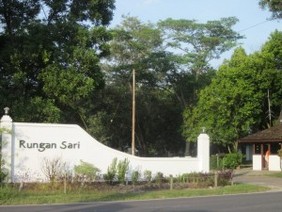
a well-paved road
goes from Palangkaraya straight to Bahrain
on the right at Kilometer 36
is the entrance to Rungan Sari Meeting Center and Resort
with a gate and a guard
on the left at Kilometer 36
is the roughly-paved road to Sukamulya, a Javanese village
after stopping at the little warung (shop)
across from Rungan Sari
we walk toward Sukamulya
a few pickup trucks and
families on motor cycles pass us by
always nodding and smiling
we pass stray cats,
a woman squatting to wash clothes in a tub,
a pile of smoking leaves and yard waste,
a wooden warung
stocked with items which we can’t identify,
and attended by an old woman sitting on a chair,
a partially built house,
seated workmen skinning six-inch thick wooden poles,
children playing in the dirt,
three scrawny chickens on the loose,
small wooden homes
one painted in stunningly bright colors–
green, blue, red,
thick forest with hints of trails
after 10 minutes of walking
we arrive at the YUM compound
YUM is a Subud Charitable Enterprise
the words in Indonesian meaning Foundation for Noble Work
we are welcomed and shown around
pictures on the wall show current projects:
malaria reduction campaign,
batik sewing enterprise,
computer education classes,
Westerners working with Indonesians
on our way back to Km 36
one of Ren’s students
beckons us to visit
we sit on the back porch
he enthusiastically brings us tea
and shyly plays his guitar for us
we meet his mother
with Indonesian greeting of holding palms
and then touching our heart
a customer arrives
she goes to take care of him
the family has a restaurant in the bottom floor
of their home
“It’s really good,” says our housekeeper, Surya
Back across the Russian Road
the Rungan Sari Resort greets visitors
the community is tucked behind
45 Indonesian style dwellings
of assorted sizes and shapes spreading out
on either side of a center strip
with soccer and basketball fields,
the latihan hall
and the school we teach in
And so Km 36 marks the crossroads
of two cultures
but what two cultures?
Western and Eastern?
English-speaking and Indonesian-speaking?
Subud and non-Subud?
white skin and brown skin?
rich and poor?
yes, significant differences
from one side of Km 36 and the other
but, or is it and
many points of interface
and palpable peace and friendliness
right now I’m watching
the Sukamulya teens and a few white dudes
playing soccer on the field here
the morning buzz of motorcycles
brings the gardeners, carpenters, housekeepers
who work in the compound
crossing the highway with the white guys
who work with Indonesians at YUM;
Gaye and Lorna have a business with boat tours
and pay their Dayak staff very well
even when it means reducing their pay
7:50 am brings the buses with 90 children
who come to the BCU school
mix with the several children who live in the compound
and with the official blessing of the Indonesian government
learn English (Inngris) so that they can participate in global commerce;
the young volunteer teachers at BCU live on a wing and a prayer
elders in the compound live okay on a tiny budget
in the West, they would be impoverished
the Subud culture is embedded with Javanese culture
in practices and inter-marriages with Westerners;
here Westerners speak Indonesian (Bahasa)
Indonesians speak English
here local Dayaks surround the airport
to protect Central Borneo from the arrival of
religious extremists and uphold the
peaceful and respectful co-existence of Muslim and Christian
 RSS Feed
RSS Feed